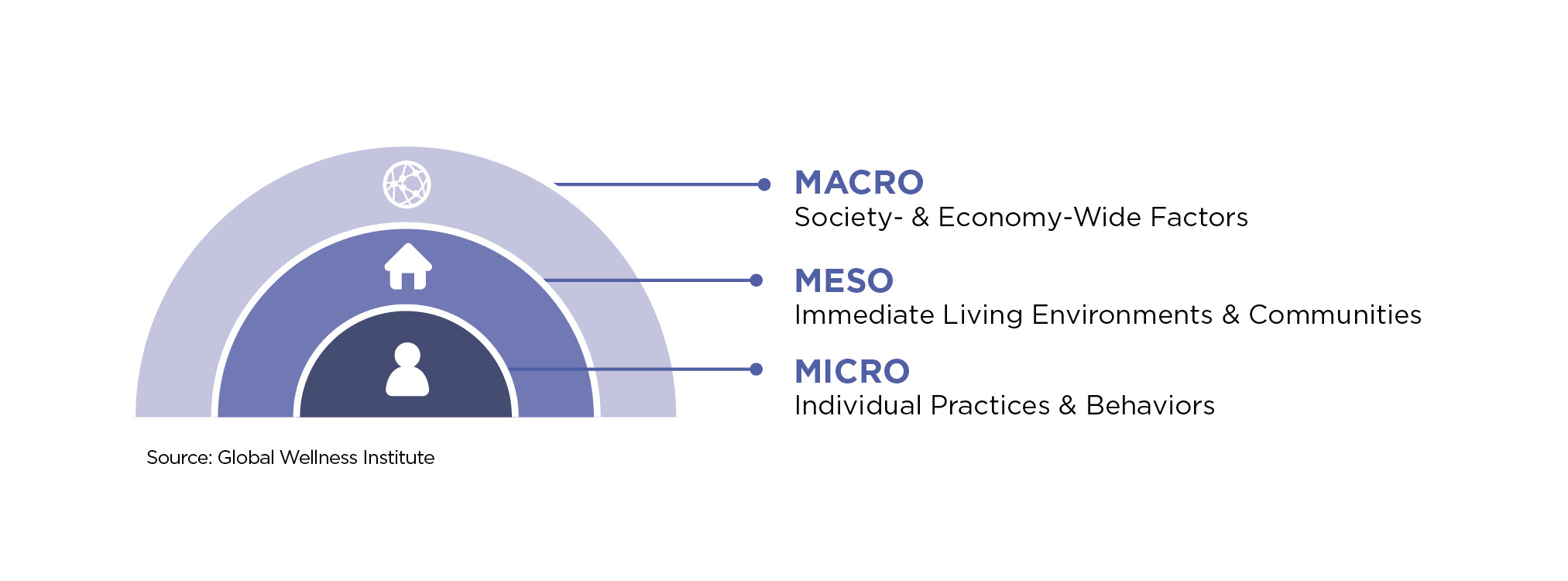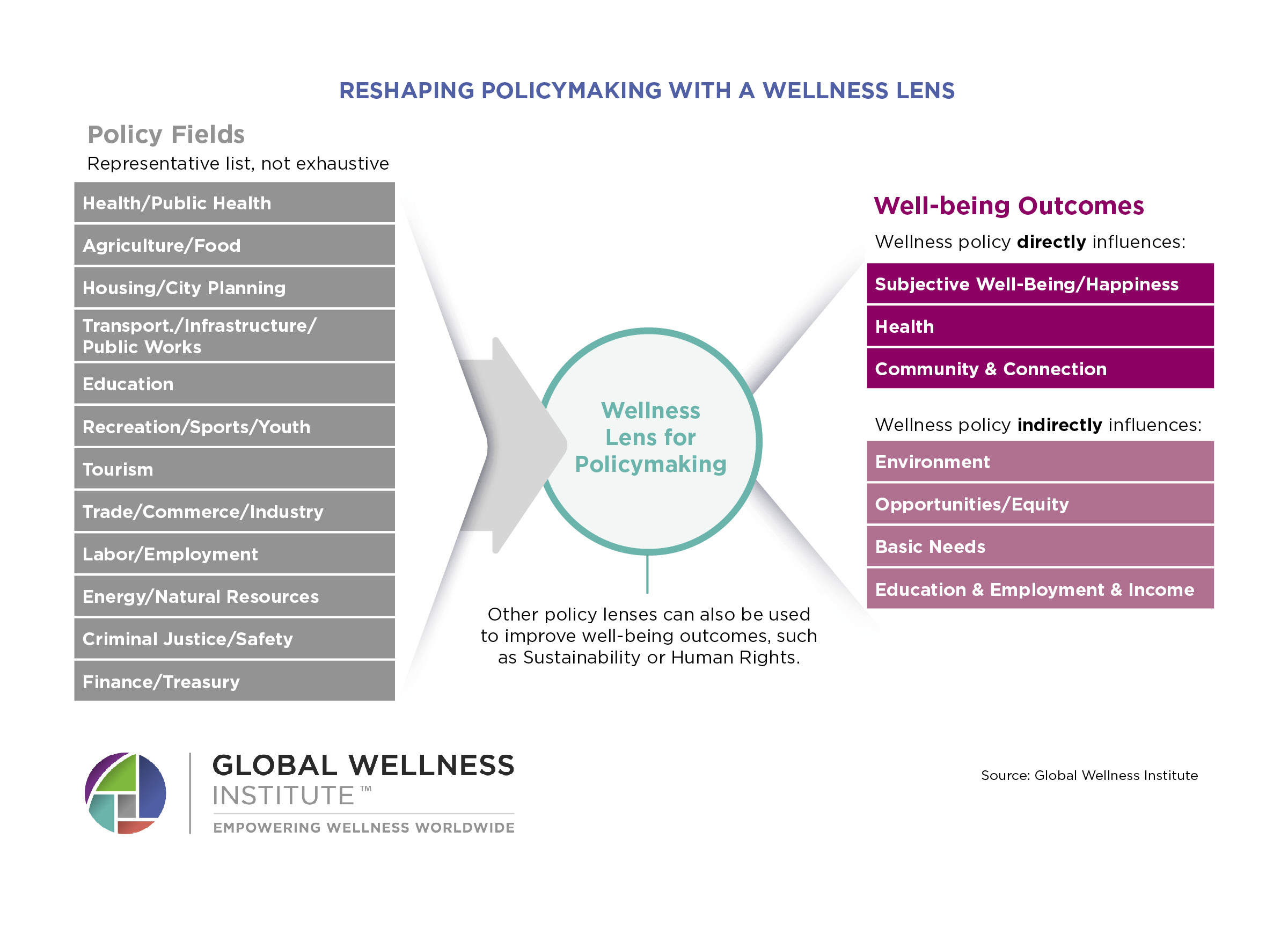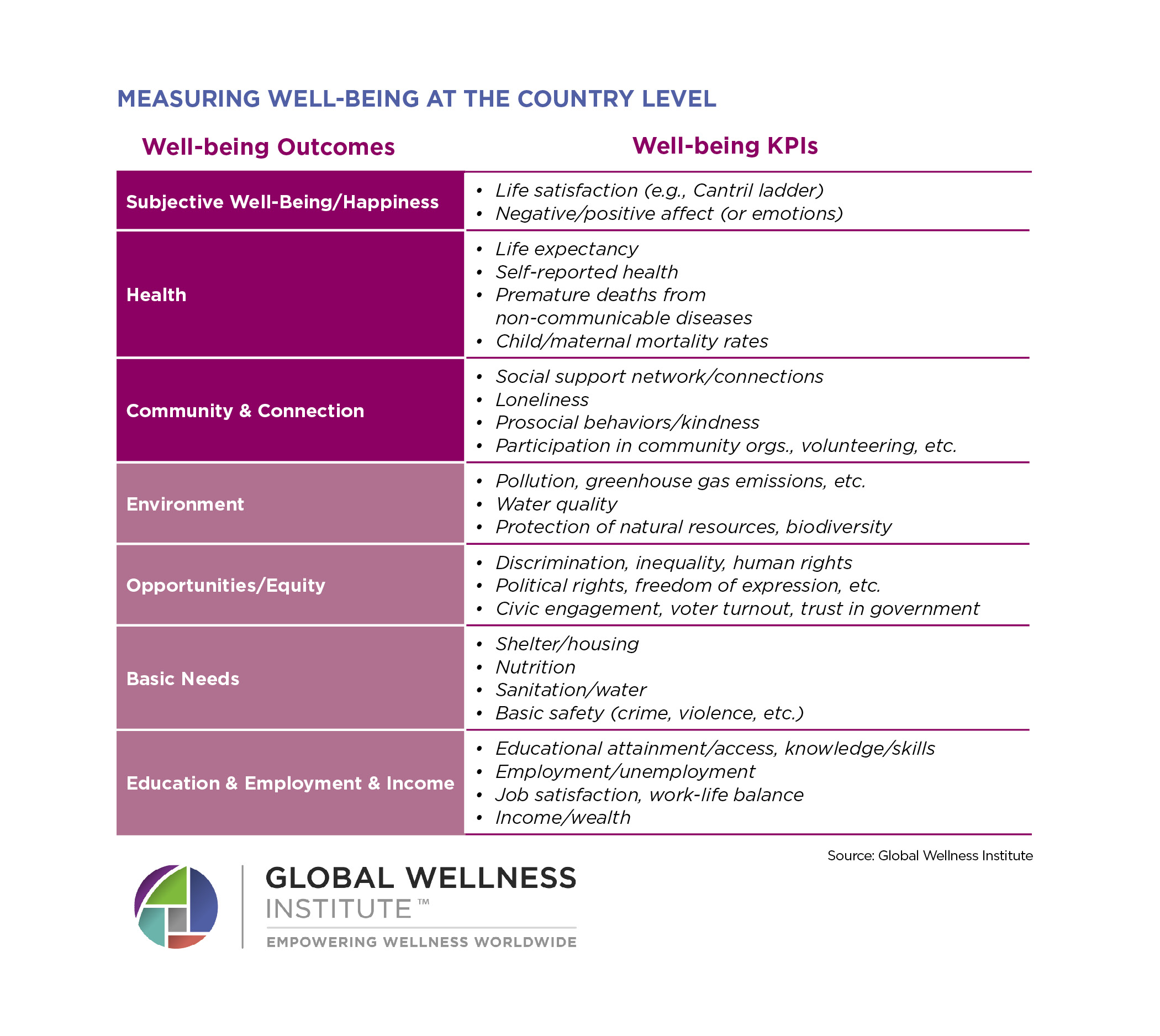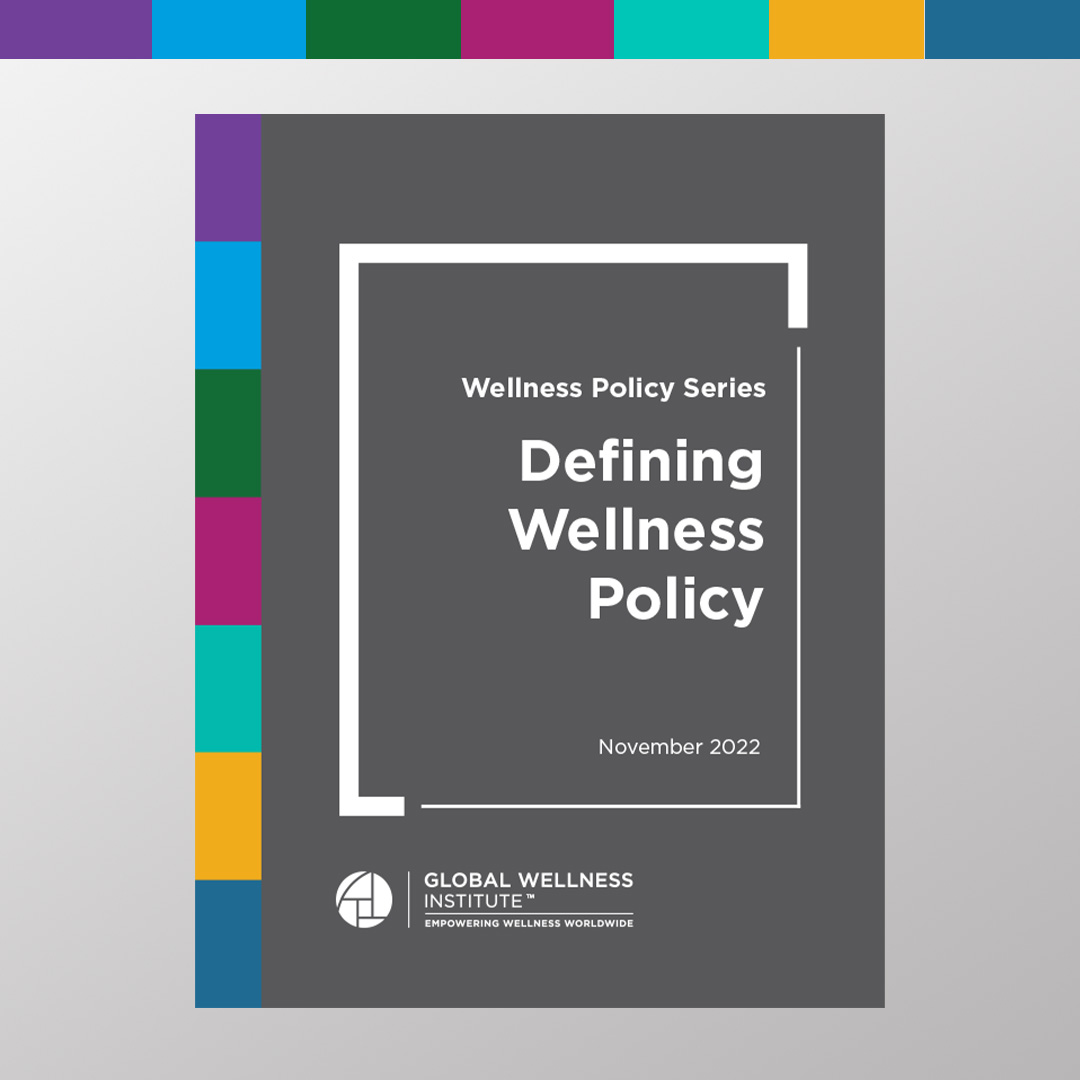Cynics may question whether all this consumer spending on wellness has any real impact on wellbeing, but GWI's new research reveals that for every roughly $800 annual increase in wellness expenditures per person, happiness levels increase 7% and life expectancy increases 1.26 years; The findings bolster the case for wellness policy, the subject of GWI's groundbreaking new report "Defining Wellness Policy," the first research to define, and argue why, wellness is the missing policy lens so desperately needed now
MIAMI, Nov. 1, 2022 /PRNewswire-PRWeb/ -- As consumer spending on wellness has exploded into a multi-trillion market, it raises key questions: Is all this spending even improving people's wellbeing and physical and mental health? Skeptics would guess no, but new research released today by the Global Wellness Institute (GWI) says, quite definitively, yes.
These findings are part of GWI's historic new report, "Defining Wellness Policy," the first research to define wellness policy and make a compelling, evidence-backed argument as to why it's so direly needed. It explains how wellness policy can complement–but also fill the glaring gaps left by–both current public health policy and new happiness and wellbeing policy efforts. It also addresses the serious gaps in the sick-care-focused medical system and in the private sector wellness industry, that clearly cannot bring wellness to all. The report includes the first-ever quantitative analysis that determines the relationship between wellness spending, health outcomes, and happiness across countries. It demonstrated that spending on wellness is strongly and positively correlated with increased longevity and happiness, not only for the "wealthy well" but across the board.
"As we dived into this research, it quickly became obvious that health and wellness should be embedded in the priorities for all policymaking," said Katherine Johnston, GWI senior research fellow. "As compared to sustainability – which has been in policy conversations for so long – it is astonishing that no one has talked about wellness as a comprehensive, cross-cutting policy category in government circles. The health of people should be paramount, just like the health of the planet, and really, the two go hand-in-hand. We hope that this study and GWI's upcoming wellness policy toolkits will kickstart a global conversation and more research in this area."
Download the free report here.
The research, unveiled at the Global Wellness Summit now being held in Tel Aviv, sets the stage for a series of Wellness Policy Toolkits to be released in 2023, which will provide governments, non-profits, communities and businesses a roadmap on how to take action in seven domains of wellness policy: physical activity, healthy eating, mental wellness, traditional/complementary medicine, wellness in the built environment, wellness at work, and wellness in tourism.
Wellness Spending = Increased Happiness and Longevity
To identify the relationship between wellness spending, happiness levels, and health outcomes, GWI researchers partnered with Dr. Shun Wang, a key author, and statistician of the World Happiness Report. Utilizing data from GWI's wellness economy reports (measuring wellness spending in more than 200 markets), Gallup's World Poll (for global happiness measurements), and the World Bank (for national life expectancy and income levels)–and then carefully adjusting for wealth levels and population size–a regression analysis revealed striking findings. Across countries, for every $844 increase in wellness spending per person, the average happiness level increases by nearly 7%. An increase of $769 in wellness spending per capita is associated with 1.26 years of extra life. While correlation does not necessarily mean causation, these important results clearly signal that there are health and wellbeing benefits from wellness spending. A forthcoming GWI white paper will expand on these results, analyzing the relationships between spending in each wellness sector–whether physical activity, healthy food, traditional medicine, or mental wellness–and how it's associated with outcome measures for health and happiness.
"This is the first time that anyone has analyzed wellness economy spending alongside data on happiness and life expectancy, and we found that investment in wellness is definitely linked to positive outcomes in these metrics," said Ophelia Yeung, GWI senior research fellow. "We believe that wellness policy is crucial for bringing the benefits of wellness to everyone, especially to those who cannot pay for it or who face barriers to living a healthy lifestyle."
More on "Defining Wellness Policy"
GWI's Wellness Policy series aims to build common language, frameworks, and strategies for governments, industry, and communities to work toward the goal of wellness for all. The report released today establishes why wellness is the missing link in policy, and how wellness policy can uniquely address the gaps in the current movements attempting to tackle our cascading health crises.
Wellness Policy – A Definition: GWI defines wellness policy as "a set of cross-cutting actions that encourage healthy lifestyles and create supportive environments for human health and wellbeing." Wellness policy is specifically focused on prevention, lifestyle changes, and the many environmental factors that affect our wellbeing.
A Desperate Need for New Solutions: If health and wellbeing metrics were precarious before the pandemic, they're now deteriorating further. We face escalating macro crises: worsening chronic disease, mental unwellness, sedentary lives, environmental destruction, an aging population, and the pressures of technology, all of which impose staggering economic costs. Global health expenditures more than doubled in the last decade, reaching $8.5 trillion annually and it is projected that chronic diseases and mental conditions will cost $47 trillion between 2011 and 2030; physical inactivity is a $67.5 billion annual burden and employee disengagement at work costs an estimated $7.8 trillion a year.
Wellness Policy Tackles:
Gaps in Healthcare & Public Health Policy: While research shows that 80-90% of our health outcomes are determined by environmental, socioeconomic, and lifestyle factors, healthcare remains primarily a "sick-care" model, while public health systems lack a mandate to address lifestyle and environmental factors. GWI estimates that only about 4% of annual global health expenditures are for prevention, risk reduction, and public health. Wellness policy refocuses public health policy on the lifestyle factors and environmental determinants of health that have the biggest impact on our wellbeing and longevity.
Gaps in the Consumer Wellness Market: The modern consumer wellness movement has accomplished much, including mainstreaming a concept of health that is holistic, destigmatizing mental health, and vastly increasing consumer choice. But it has left glaring gaps in accessibility and affordability, and cannot bring wellness to all. Among the $4.4 trillion of wellness economy spending in 2020, only 6% was in "lower-middle" and "low-income" countries. Wellness is a powerful concept for policy action because it taps into the language and aspirational desires of consumers, but can ensure that access to wellness is far more equitable and inclusive.
Gaps in Happiness & Wellbeing Policy: Happiness and wellbeing have entered the mainstream lexicon, but their impact on policy remains limited. The conversation is still mostly theoretical and only a few (mostly small and wealthy countries, such as New Zealand, Wales, and Scotland) have embedded happiness and wellbeing into their national budgeting priorities. The problem is that happiness and wellbeing policy takes a top-down approach that requires long-term, monumental change in how governments set priorities and allocate resources. In contrast, a wellness policy approach focuses on making incremental, immediate, bottom-up changes within existing policy structures, and changes that have a deeper impact on human health than merely improving subjective wellbeing.
This research was generously sponsored by these companies: Art of Cryo, Biologique Recherche, Blue Zones Center, Canyon Ranch, Carillon Miami Wellness Resort, Fountain Life, HB Reavis, The John W. Brick Foundation, Magleby Development, MindBody, Natura Bissé, Rancho La Puerta, Rancho Mission Viejo, Six Senses, Technogym and Universal Companies.
Graphs from the research are here.
About the Global Wellness Institute: The Global Wellness Institute (GWI), a nonprofit 501(c)(3), is considered the leading global research and educational resource for the global wellness industry and is known for introducing major industry initiatives and regional events that bring together leaders to chart the future. GWI positively impacts global health and wellness by educating public institutions, businesses and individuals on how they can work to prevent disease, reduce stress and enhance the overall quality of life. Its mission is to empower wellness worldwide.
Media Contact
Beth McGroarty, Global Wellness Institute, +1 213-300-0107, [email protected]
SOURCE Global Wellness Institute








Share this article